Last updated Saturday, 07-Jun-2003 09:58:34 EDT
Finally - private space, with power!
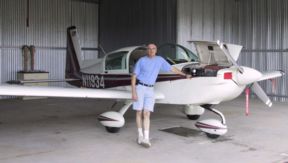
Photo by unknown.
Time flies. Come May 2001, a year after the pre-purchase annual, my Tiger went in for an annual inspection at Kettunen Aeronautical, Inc. at Ashtabula County Airport, HZY. The boss, Alan Kettunen is a very highly regarded A&P, IA, CFI, CFII, etc.
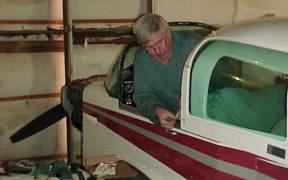
Photo by unknown.
Alan allowed me to "help" making it an owner impeded annual. Nevertheless, I sure learned a lot about my plane while only ruining one T-shirt.
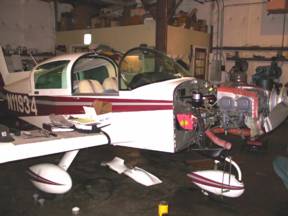
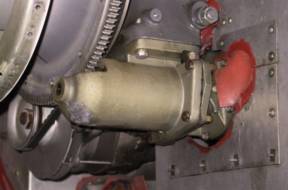
Out with a Prestolite starter...
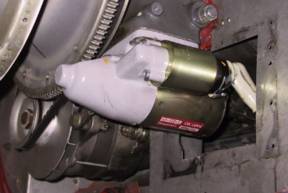 and in with a SkyTec starter (lighter and faster).
and in with a SkyTec starter (lighter and faster).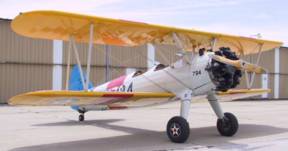
I had already long planned to get instrument rated. Why should I spend the time and money to get an instrument rating? Flying is after all "just" a hobby.
The best reason was simply safety. It is all too easy to go aloft on a Visual Meteorological Conditions (VMC) day and find yourself in Instrument Meteorological Conditions (IMC), i.e., clouds! Weather forecasts are just that - forecasts. Also, learning to fly by reference to instruments makes night flying far safer as you no longer need to depend on sometimes illusionary (or non-existent) out-the-window references to figure out which way is up.
Either way, without the instrument training, one might too easily be subjected to spatial disorientation and get into a dangerous situation.
Further, one get much better service from the Air Traffic Control (ATC) system if you fly under Instrument Flight Rules (IFR) rather than under Visual Flight Rules (VFR). These services include constant contact with ATC with radar tracking, separation from other aircraft and sequencing into airport environments for landing.
To get the instrument rating I'd have to...
- Pass the FAA instrument rating knowledge test
- Log 50 or more hours of cross-country Pilot-In-Command (PIC) time
- Acquire at least 40-hours of simulated or actual instrument time including at least 15-hours from a Certified Flight Instructor, Instruments (CFII)
- Make one more than 250 nautical mile instrument training flight along airways that includes at least three instrument approaches for landing
- Obtain a sign-off from your CFII attesting to your readiness for the (flight) practical test (a.k.a the check ride).
The next question for me to answer was how to get the training? My options were to use...
- a local flight school at CGF or BKL (either their plane or mine)
- T&G Flying Club
- Cleveland Airsports
- American Flyers - a 10-day cram course at home with my plane
- Professional Instrument Courses (PIC) - a remote 7 or 10-day school (either their plane or mine)
- GATTS
- Morey's West Coast Adventures - a local free-lance instructor and my plane
Somewhat by lucky happen stance I ended up with option four. In the process of arranging to sublet a CC hanger, the Cuyahoga County Airport folks were kind enough to put me in contact with someone interested in subletting my T hanger space from me. That gave me a hanger to return to should I lose the CC space. Anyway, the person interested in renting my hanger was/is a CFII, Debbie.
Debbie and I took a flight in my Tiger on 18-March-2001 to see if we "clicked" as instructed and student. We did!
She was in the process of achieving her Nurse Practitioner certification and was too busy to start right away. I was also busy at home. We agreed to start my training after her certification and after my Tiger came out of its annual inspection.
My training began in earnest on 20-May-2001.
Training started with practice at various maneuvers meant to perfect stable flying. Airplane control was key. This meant knowing the "numbers" for the particular plane for different intents. For example, knowing the RPMs and pitch angle for a steady descent at 90kts and 500'/minute.
Once the pilot/plane calibration was taken care of, next came lots and lots of flying "under the hood." That's jargon for wearing blinders that limit your view to the instruments.
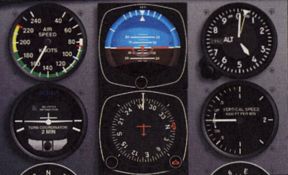
Image courtesy of "textbook."

Training went forward in fits and starts and eventually Debbie declared me ready for the checkride. Using the same examiner as had tested me for the private pilot certificate I took the checkride on November 11, 2001 and passed.
All throughout training I had intended to get a photograph of Debbie - and didn't. Finally, in June 2002 I snapped her in front of my new airplane, but that's another tale...
Meanwhile, my Tiger mentor (and this web server's administrator), Rob Logan decided to build a Lancair Legacy 2000.
He's making good progress, but still has a long way to go.

Photo by Rob.
supervised by none other than Orville himself!
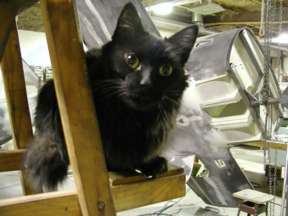
Photo by Rob.
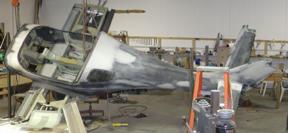
Photo by Rob.
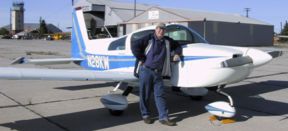
Photo by unknown.
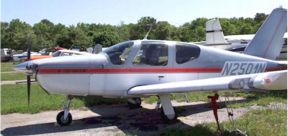
Photo by Larry.